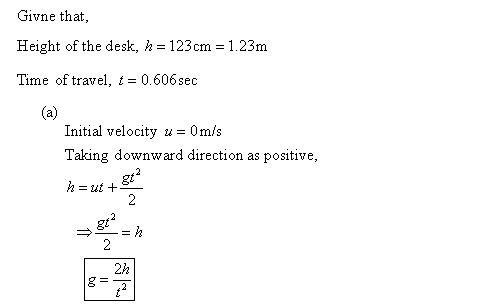You and your friend would like to experimentally determine a value for g, an object's acceleration due to gravity on Earth. Your friend sets a baseball on the edge of a desk, and you crouch down by the floor, waiting for the ball to drop. She pushes the ball off the desk and yells GO! to signal you to press START your phone's stopwatch app. When the ball hits the floor, you press STOP on the app to stop the timer, and see that the time reads t = 0.606 s. Using a tape measure with markings for cm, you measure the top of the desk to be h = 123 cm from the floor. Part 1) Assuming the ball started with no initial vertical velocity, calculate the value of g in your experiment symbolically. Assume that g is a positive number. Part 2) Using your previous symbolic answer and the qualities from the experiment, determine a numeric value for g.
You and your friend would like to experimentally determine a value for g, an object's acceleration due to gravity on Earth. Your friend sets a baseball on the edge of a desk, and you crouch down by the floor, waiting for the ball to drop. She pushes the ball off the desk and yells GO! to signal you to press START your phone's stopwatch app. When the ball hits the floor, you press STOP on the app to stop the timer, and see that the time reads t = 0.606 s. Using a tape measure with markings for cm, you measure the top of the desk to be h = 123 cm from the floor.
Part 1) Assuming the ball started with no initial vertical velocity, calculate the value of g in your experiment symbolically. Assume that g is a positive number.
Part 2) Using your previous symbolic answer and the qualities from the experiment, determine a numeric value for g.
Part 3) What is a reasonable quantitative estimate for your uncertainty in stopping the timer, sigma t? What about your error in measuring the height of the desk, sigma h ?
Part 4) Compute the propagated uncertainty in t^2 and 2h. Use these to compute the absolute uncertainty in g.
Part 5) What is your relative uncertainty on g as a percentage? What experimental improvements would you suggest to validate your findings and possible get a value of g closer to 9.8 m/s^2 ?
Please answer all parts of this question.
Since we only answer up to 3 sub-parts, we’ll answer the first 3. Please resubmit the question and specify the other subparts (up to 3) you’d like answered
\
Step by step
Solved in 2 steps with 2 images

For part D and E, how did you get the numbers 9.8 and 6.69?
Please please help me on this! Thank you
Thank you.
Can someone please help me with answering parts D and E ?
Please please help